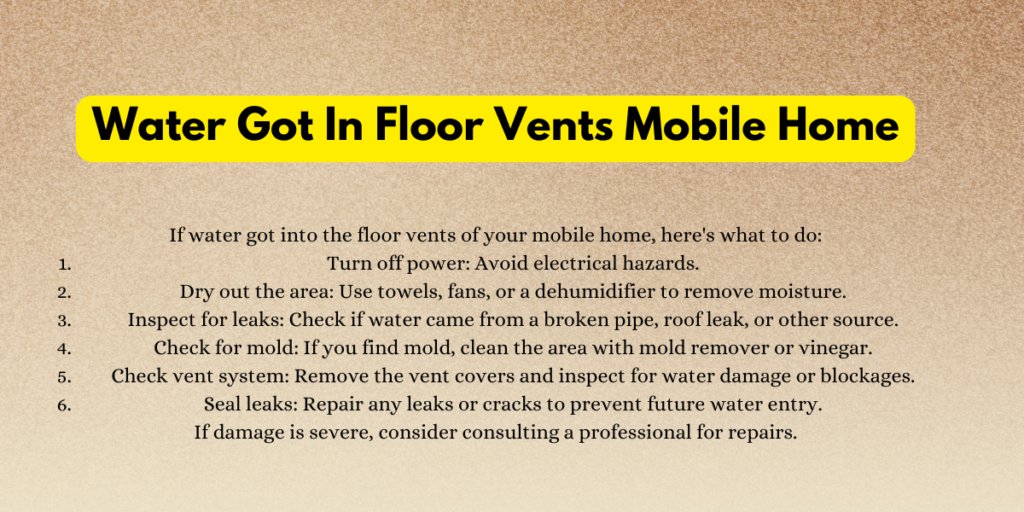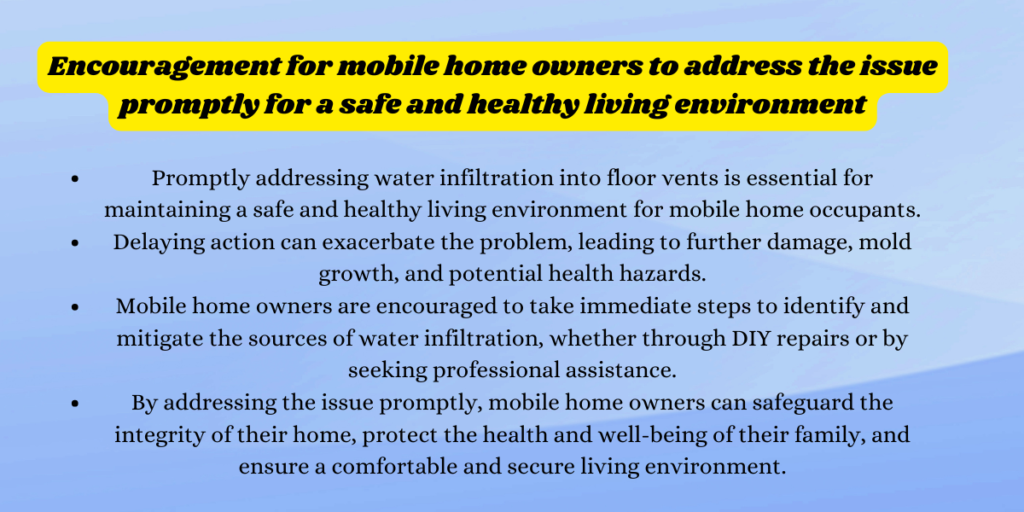Hello guys,
Water Got In Floor Vents Mobile Home- Water entering floor vents is a common issue that many mobile home owners may encounter, yet it’s often overlooked or underestimated. In this guide, we’ll delve into the problem of water infiltration into floor vents in mobile homes and explore why it’s essential for homeowners to address this issue promptly.
Water Got In Floor Vents Mobile Home
When water manages to infiltrate the holes in a mobile home floor, it can cause problems ranging from structural damage to potential health hazards. Here’s what happens when water enters these vents:
Source of Infiltration
Water can enter the pores of the floor in different ways. This can be caused by damaged shingles or faulty seals, plumbing accidents under the mobile home, or leaks in the roof due to poor drainage around the property. Regardless of the source, once water penetrates a hole, it presents many problems.
Structural Deterioration
Moisture infiltration through pores can wreak havoc on the structural integrity of the flooring and surrounding areas. Over time, this can cause wood components to rot, floor joists to weaken, and floors to rot or even collapse. Damage is not limited to the area near the vent; If left unchecked, it can spread to other parts of the mobile home.
Mold and Fungus Growth
Where there is moisture, there is a high chance of mold and mildew growth. These fungal invaders thrive in moist environments and quickly spread throughout the ductwork and beyond. In addition to causing unsightly stains and odors, mold and mildew can pose serious health risks, especially to individuals with respiratory conditions or weakened immune systems.
HVAC System Compromise
Water infiltration can compromise HVAC (Heating, Ventilation and Air Conditioning) system performance. Components such as the blower motor, air handler and ductwork are vulnerable to corrosion and damage when exposed to moisture for long periods of time. This can cause malfunctions, reduced performance, and expensive repairs or replacements.
Health Hazards
Beyond structural and mechanical effects, water in floor holes presents potential health hazards to occupants. Airborne mold spores can cause allergic reactions, respiratory problems, and other health problems. In addition, unclean water may contain bacteria or other contaminants, increasing the risk to health and well-being.
In short, water seeping into floor holes isn’t just a nuisance; This is a serious problem that calls for swift and decisive action. From identifying and addressing sources of infiltration to minimizing damage and ensuring proper ventilation and drainage, proactive measures are necessary to protect the integrity of the mobile home and its occupants.

Water entering floor vents in mobile homes
Water Got In Floor Vents Mobile Home- Of course! When we talk about water ingress through floor holes in mobile homes, we are referring to situations where moisture enters the ductwork and vents that are typically located in mobile home floors. This can be caused by a variety of reasons, such as roof leaks, plumbing problems, poor drainage, or condensation build-up.
Water seeping into floor holes is an important concern because it can cause a number of problems:
Mold and Fungus Growth
Moisture provides the perfect breeding ground for mold and mildew. When water enters the pores, it creates a moist environment where these harmful microorganisms can grow. Mold and mildew not only cause unpleasant odors, but can pose a health hazard to residents, especially those with respiratory problems.
HVAC System Damage
Water entering ductwork can damage HVAC (Heating, Ventilation and Air Conditioning) system components. This includes the air handler, blower motor and ductwork. Water can corrode, corrode and damage these components, reducing system performance.
Flooring and surrounding structure degradation
Water Got In Floor Vents Mobile Home: Excess moisture from water seeping into floor holes can seep into flooring materials and surrounding structures, such as subfloors and floor joists. Over time, this moisture can cause the wood to rot, weaken the structural integrity of the floor, and potentially compromise the stability of the entire mobile home.
Overall, water seeping into floor holes in mobile homes is a serious problem that needs to be addressed immediately to prevent further damage and ensure a safe and healthy living environment for the occupants. Identifying the source of water ingress and taking appropriate measures to minimize it is essential to maintain the integrity of the home and avoid costly repairs in the long run.
Common Causes Of Water In Floor Vents
Certainly! Let’s delve into each of the common causes of water in floor vents in more detail:
Poor drainage around the mobile home
- When the area surrounding the mobile home lacks proper drainage, rainwater or runoff from the roof may collect near the foundation.
- Over time, this standing water can seep into the ground below the mobile home and infiltrate the crawl space or underbelly.
- If the floor vents are located in areas affected by poor drainage, water may find its way into the ductwork, leading to moisture issues inside the home.
How To Replace Broken Glass In A Mobile Home Window
Roof leaks and damaged roofing materials
- Roof leaks occur when the roofing materials, such as shingles or flashing, become damaged or deteriorated.
- Rainwater can penetrate these vulnerabilities and enter the attic space of the mobile home.
- From there, the water may trickle down through the ceiling and reach the floor vents, especially if they are located on the lower levels of the home.
Plumbing leaks beneath the mobile home
- Leaks in the plumbing system underneath the mobile home can result in water seepage into the crawl space or underfloor area.
- If the floor vents are situated near the site of the plumbing leak, water may find its way into the ductwork through gaps or cracks in the flooring.
Condensation buildup inside ductwork
- Condensation can form inside the ductwork when warm, humid air comes into contact with cooler surfaces, such as air conditioning ducts.
- Poor insulation or ventilation in the ductwork can exacerbate this issue, leading to excessive condensation accumulation.
- The water droplets may eventually drip into the floor vents, particularly in areas with high humidity levels or fluctuating temperatures.
Inadequate ventilation in the crawlspace or beneath the home
- Inadequate ventilation in the crawl space or underbelly of the mobile home can contribute to moisture buildup.
- Without proper airflow to remove excess moisture, humidity levels may rise, creating a conducive environment for water-related issues.
- Moisture may migrate into the ductwork through the floor vents, especially if there are gaps or openings in the ducts or flooring.
Water Got In Floor Vents Mobile Home: By addressing these common causes of water in floor vents, mobile homeowners can take proactive steps to prevent water infiltration and mitigate potential damage to their homes. Regular maintenance, inspections, and repairs are crucial for safeguarding against moisture-related issues and maintaining a dry and healthy living environment.
Potential Risks and Consequences
Water Got In Floor Vents Mobile Home
Certainly! Let’s explore the potential risks and consequences associated with water in floor vents in more detail:
Mold and mildew growth
- Moisture from water infiltration creates an ideal environment for mold and mildew to thrive.
- Meld and mildew can spread rapidly within the ductwork and surrounding areas, including walls, floors, and ceilings.
- Exposure to meld spores can trigger allergic reactions, respiratory issues, and other health problems, particularly for individuals with asthma or allergies.
Damage to the HVAC system
- Water infiltration into the ductwork can compromise the functionality of the HVAC (Heating, Ventilation, and Air Conditioning) system.
- Components such as the blower motor, air handler, and ductwork are susceptible to corrosion, rusting, and deterioration when exposed to moisture.
- Damage to the HVAC system can lead to malfunctions, reduced efficiency, and costly repairs or replacements.
Deterioration of flooring and surrounding structures
- Excessive moisture from water in floor vents can cause deterioration of the flooring material and surrounding structures.
- Wooden components, such as floor joists and subfloors, are particularly vulnerable to rotting and decay.
- Damp conditions can also promote the growth of fungi, such as wood rot fungi, further compromising the structural integrity of the home.
Water Got In Floor Vents Mobile Home: Overall, the potential risks and consequences of water in floor vents extend beyond cosmetic damage to the home. Mold and mildew growth can jeopardize indoor air quality and pose health risks to occupants. Damage to the HVAC system can result in discomfort and increased energy costs. Deterioration of flooring and surrounding structures can compromise the safety and stability of the mobile home. Addressing water infiltration promptly and effectively is essential for mitigating these risks and preserving the integrity of the home.

Addressing Water In Floor Vents
Let’s break down each step in addressing water in floor vents in more detail:
Inspect for damage and leaks
- Begin by thoroughly inspecting the mobile home for any signs of water damage or leaks. This includes checking the roof for missing shingles, damaged flashing, or signs of water intrusion.
- Inspect the plumbing system beneath the home for leaks or damaged pipes. Look for any water stains, mold growth, or unusual odors that may indicate water infiltration.
- Check the condition of the floor vents themselves, ensuring they are properly sealed and free from cracks or openings where water could enter.
Improve drainage around the home
- Take steps to improve the drainage around the mobile home to prevent water from pooling near the foundation.
- Ensure that gutters and downspouts are clear of debris and directing water away from the home.
- Consider grading the ground around the home to promote proper drainage away from the foundation.
Seal vents temporarily during heavy rain or flooding
- During periods of heavy rain or flooding, consider temporarily sealing the floor vents to prevent water from entering the ductwork.
- Use waterproof materials such as plastic sheeting or duct tape to cover the vents until the risk of water infiltration has passed.
- Remember to remove the temporary seals once the threat of water damage has subsided to allow for proper ventilation.
Enhance insulation and ventilation in the crawlspace
- Improve insulation and ventilation in the crawl space or beneath the mobile home to prevent condensation buildup and moisture accumulation.
- Install vapor barriers or insulation to reduce moisture infiltration from the ground.
- Ensure that vents in the crawl space are clear and unobstructed to promote airflow and prevent stagnation.
Consider hiring a professional for assessment and repairs
- If you’re unsure about the cause of the water infiltration or how to address it effectively, consider hiring a professional contractor or HVAC technician for assessment and repairs.
- A professional can conduct a thorough inspection of the mobile home, identify the source of the water infiltration, and recommend appropriate solutions.
- They can also perform any necessary repairs or modifications to ensure the problem is addressed properly and prevent future water damage.
Water Got In Floor Vents Mobile Home- By following these steps to address water in floor vents, mobile home owners can effectively mitigate the risk of water damage and maintain a safe and healthy living environment. Regular maintenance and proactive measures are key to protecting the integrity of the home and ensuring the well-being of its occupants.
Conclusion
Importance of taking proactive measures to prevent water damage
- Water damage can have significant repercussions on the structural integrity, safety, and health of a mobile home and its occupants.
- By taking proactive measures to prevent water infiltration and damage, mobile home owners can avoid costly repairs, health hazards, and inconvenience in the long run.
- Proactive measures may include regular inspections, maintenance, and repairs to identify and address potential sources of water intrusion before they escalate into larger issues.
- Investing time and resources in preventative measures can ultimately save mobile home owners time, money, and stress by minimizing the risk of water-related problems.
Encouragement for mobile home owners to address the issue promptly for a safe and healthy living environment
- Promptly addressing water infiltration into floor vents is essential for maintaining a safe and healthy living environment for mobile home occupants.
- Delaying action can exacerbate the problem, leading to further damage, mold growth, and potential health hazards.
- Mobile home owners are encouraged to take immediate steps to identify and mitigate the sources of water infiltration, whether through DIY repairs or by seeking professional assistance.
- By addressing the issue promptly, mobile home owners can safeguard the integrity of their home, protect the health and well-being of their family, and ensure a comfortable and secure living environment.
Water Got In Floor Vents Mobile Home In conclusion, taking proactive measures to prevent water damage and addressing water infiltration into floor vents promptly are crucial steps for mobile home owners to protect their investment, maintain a safe and healthy living environment, and enjoy peace of mind. By staying vigilant, proactive, and responsive to water-related issues, mobile home owners can mitigate risks, minimize damage, and preserve the integrity and value of their home for years to come.

